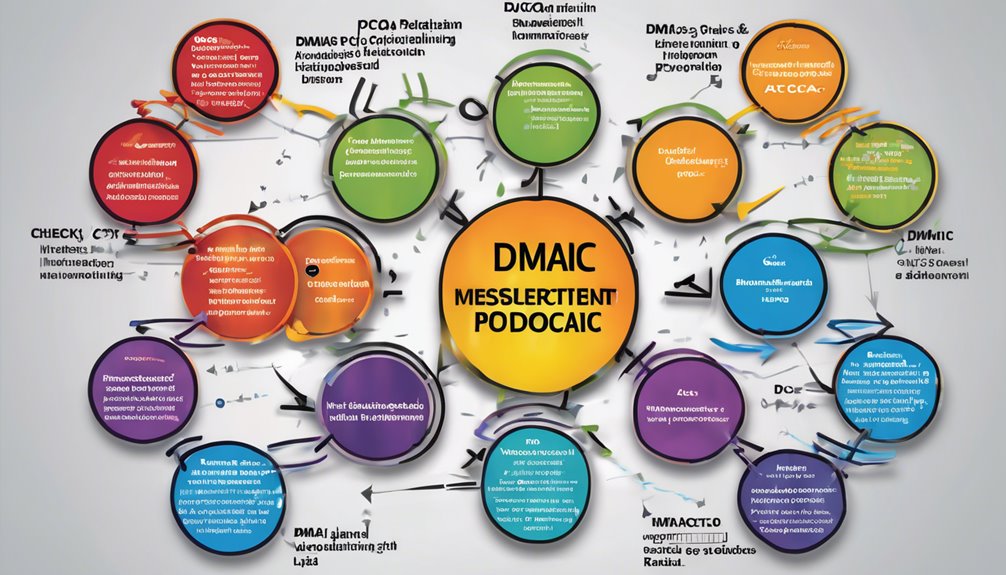When it comes to choosing a framework for process improvement, you might find yourself weighing DMAIC against PDCA. Each methodology has its strengths and is suited for different scenarios. Understanding the nuances between them can significantly impact your organization's efficiency and effectiveness. So, which one should you adopt for your next project? Let's explore the key features and applications of both to help you make an informed decision.
Overview of DMAIC

DMAIC, a core component of Six Sigma, is a structured problem-solving methodology designed to improve processes. It stands for Define, Measure, Analyze, Improve, and Control.
You start by defining the problem and setting clear objectives. Next, you measure the current performance to gather relevant data.
In the analyze phase, you identify the root causes of issues through careful examination of the data. Once you've pinpointed the causes, you move to improve, where you develop and implement solutions.
Finally, in the control stage, you establish monitoring systems to ensure the improvements are sustained over time. This model is particularly effective because it fosters a culture of continuous improvement within organizations.
Overview of PDCA
While both PDCA and DMAIC aim to improve processes, PDCA, which stands for Plan, Do, Check, Act, provides a more iterative approach.
You start by identifying a problem or opportunity in the planning phase, where you develop a strategy. Next, you implement your plan in the "Do" stage, making the necessary changes.
After that, you check the results to see if your actions led to improvements. This evaluation helps you understand what worked and what didn't.
Finally, in the "Act" phase, you can standardize successful changes or adjust your approach based on the feedback. This cycle encourages ongoing refinement, making it a practical tool for continuous improvement in a variety of settings.
Embracing PDCA can lead to sustainable success, as it aligns with the principles of continuous improvement that foster a culture of ongoing enhancement.
Key Differences Between DMAIC and PDCA

When comparing DMAIC and PDCA, it's crucial to recognize their distinct approaches to process improvement.
DMAIC, which stands for Define, Measure, Analyze, Improve, and Control, focuses on solving specific problems within a process. It's data-driven and often used in Six Sigma methodologies.
On the other hand, PDCA, or Plan-Do-Check-Act, emphasizes continuous improvement through iterative cycles. You plan a change, implement it, check its effectiveness, and act based on what you learned.
While DMAIC is more structured and analytical, PDCA is more flexible and adaptable. Understanding these differences helps you choose the right framework for your needs.
DMAIC is particularly effective in reducing variations and enhancing quality in processes, making it a valuable tool for organizations aiming for operational excellence.
Whether you're addressing a specific issue or looking to foster ongoing improvements, knowing their strengths can guide your decision.
When to Use DMAIC
If you're facing a specific problem within a process, DMAIC is an ideal choice to guide your improvement efforts.
It's perfect when the issue is well-defined and you need a structured approach to solve it. Use DMAIC when you want to enhance quality, reduce defects, or improve efficiency.
This method helps you analyze data thoroughly, ensuring you pinpoint the root causes of problems. If you're working on a project where you can measure results, DMAIC provides a clear framework for tracking your progress.
It's especially beneficial in complex processes where changes can significantly impact outcomes. Additionally, employing data-driven decision-making ensures that your solutions are based on solid evidence rather than assumptions.
When to Use PDCA

Knowing the right moment to use PDCA can make a significant difference in your continuous improvement efforts.
You should consider PDCA when you're dealing with smaller, manageable changes that require iterative testing and refinement. It's perfect for processes needing regular updates or adjustments, allowing you to implement changes quickly and gather feedback.
If you find that a problem is recurring but not severe, PDCA helps you address it without extensive analysis. Use PDCA when fostering a culture of continuous improvement, encouraging team involvement, and promoting collaboration.
It's also an excellent choice for experimentation, where you can test out new ideas on a smaller scale before broader implementation. Trust your instincts and choose PDCA for incremental, ongoing enhancements. Additionally, leveraging continuous improvement practices can further enhance the effectiveness of your PDCA cycles.
Case Studies: Success Stories of DMAIC and PDCA
While both DMAIC and PDCA have proven effective in various contexts, real-world case studies highlight their unique strengths in driving continuous improvement.
For instance, a manufacturing company used DMAIC to reduce defects in their production line. By defining the problem and analyzing root causes, they achieved a 30% reduction in defects within six months.
On the other hand, a service organization applied PDCA to enhance customer satisfaction. By implementing small changes and continuously testing them, they improved their satisfaction scores by 25% over a year.
These examples show how DMAIC's structured approach excels in problem-solving, while PDCA's iterative nature fosters gradual improvements. Additionally, utilizing data collection techniques effectively can significantly enhance the outcomes of both methodologies.
Both methodologies have their place, depending on the specific challenges you face.
Choosing the Right Methodology for Your Organization

How do you determine which methodology—DMAIC or PDCA—is best suited for your organization?
Start by assessing your specific needs. If you're tackling a complex problem that requires data-driven analysis, DMAIC might be your best bet. It focuses on understanding the root causes and implementing lasting solutions.
On the other hand, if you're looking for a continuous improvement approach with a simpler, iterative cycle, PDCA could be ideal.
Consider your team's familiarity with each method; training costs and time can influence your decision. Also, think about your organizational culture—do you prefer structured processes or more flexible frameworks? Additionally, understanding customer requirements is crucial in selecting the right methodology to ensure your project aligns with stakeholder expectations.
Ultimately, align the choice with your strategic goals to ensure effective implementation and sustainable results.
Conclusion
In conclusion, choosing between DMAIC and PDCA depends on your specific needs. If you're tackling complex problems that require deep analysis, DMAIC's structured approach can lead to significant improvements. On the other hand, if you're aimed at fostering a culture of continuous enhancement with smaller, incremental changes, PDCA might be your best bet. By understanding these methodologies and their applications, you can make informed decisions that drive positive results in your organization.

